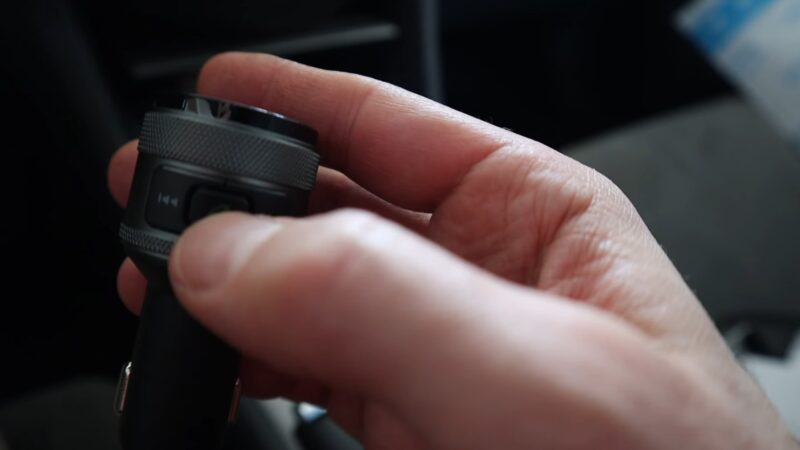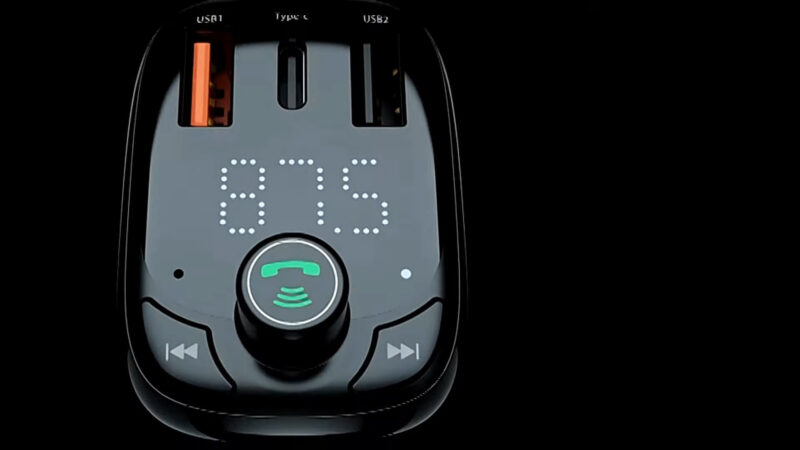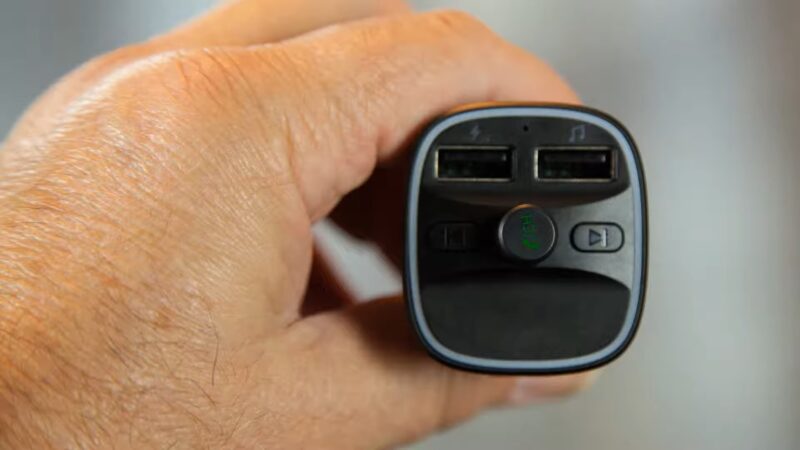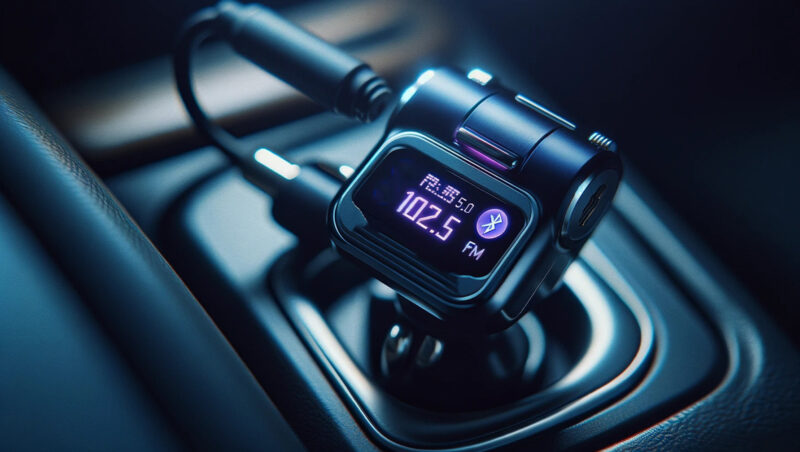Imagine being able to broadcast your favorite playlist directly from your smartphone to your car’s radio without any wires or Bluetooth connectivity. That’s the magic of an FM transmitter!
In this blog post, we will explore how they work, their applications, and why they are still relevant in our Bluetooth and Wi-Fi-dominated world.
Key Takeaways
- FM transmitters convert audio output into FM radio signals.
- They are designed to work with any FM receiver, offering broad compatibility with devices ranging from modern car stereos to old portable radios.
- They are small, portable, and require minimal technical knowledge to set up, making them user-friendly and convenient for on-the-go use.
- Digital FM transmitters offer clearer audio, are less prone to interference, and provide more precise control.
- Modern FM transmitters often include Bluetooth connectivity, allowing them to function as a bridge between older radio systems and modern Bluetooth-enabled devices.
- They have limitations such as a restricted broadcasting range and potential sound quality issues, especially under interference or at the edge of their range.
What is an FM Transmitter?
An FM transmitter is a device that converts audio output into an FM radio signal. It can broadcast sound from any audio source, like a smartphone or MP3 player, to a standard FM radio receiver.
The transmitter emits radio waves of a specific frequency which your FM radio can tune into. This technology bridges the gap between non-radio devices and FM radio receivers, allowing for a wider range of audio sources to be broadcast.
It’s a versatile tool in wireless audio transmission, serving various needs from personal use to professional settings. Notably, FM transmitters are invaluable in areas where digital streaming is not feasible due to connectivity issues.
How Does it Work?
FM transmitters work by using frequency modulation. In simple terms, they vary the frequency of the carrier wave to match the input of the audio signal.
The transmitter consists of an oscillator to produce the radio wave, a modulator to vary the frequency, and an antenna to emit the signal. The oscillator creates a steady radio frequency, which is then altered in frequency in response to the incoming audio signal.
This modulation process ensures that the transmitted signal carries the audio information over a distance. The antenna plays a critical role in dispersing these radio waves into the surrounding environment, where they can be picked up by any FM receiver.
Applications

In-Car Entertainment
One of the most common uses of FM transmitters is in cars. They allow drivers to play audio from portable devices through the car’s stereo system without needing Bluetooth or auxiliary inputs.
This is particularly useful in older car models that lack modern connectivity options, providing a simple yet effective solution for in-car entertainment. It also enhances safety, as drivers can control their music or take hands-free calls without physically handling their devices.
FM transmitters in cars are a cost-effective alternative to upgrading the entire audio system, making them popular among users who prefer a simple plug-and-play solution.
Personal Broadcasting
FM transmitters enable personal broadcasting on a small scale. You can set up your mini radio station for special events or even as a hobby.
This allows for a unique form of expression and communication within local communities, fostering a sense of connection and shared interests. Whether it’s broadcasting at local sports events, community gatherings, or even in educational settings, these transmitters provide a platform for sharing information and entertainment.
Moreover, this can be an exciting way to learn about radio broadcasting and electronics.
Assisting the Hearing Impaired
Some FM transmitters are used in assistive listening devices for the hearing impaired, transmitting audio directly to specialized receivers. This application is crucial in environments like theaters, churches, and lecture halls, where it’s important that everyone, regardless of hearing ability, has access to clear audio.
These systems can be tailored to individual needs, allowing users to adjust volume and settings according to their requirements. Additionally, such applications of FM transmitters demonstrate their versatility and importance beyond just entertainment, playing a significant role in accessibility and inclusivity.
Advantages and Limitations

Advantages
- Compatibility: FM transmitters work with any FM receiver, making them universally applicable. This broad compatibility means you don’t need to worry about different standards or connections across devices. Whether it’s a modern car stereo or an old portable radio, an FM transmitter can connect to it. This universality is a significant advantage, especially in situations where newer technologies like Bluetooth are not available. Additionally, this compatibility extends across international boundaries, as FM radio standards are globally consistent.
- Portability: Most FM transmitters are small and easy to transport. Their compact size means they can be easily carried in a pocket, purse, or glove compartment, making them ideal for on-the-go use. This portability is especially beneficial for travelers who may need to connect to various audio systems. Unlike larger audio equipment, these transmitters require no complex setup or installation, offering convenience and flexibility. Furthermore, their wireless nature means there are no cumbersome cables to manage or connect.
- Ease of Use: Setting up an FM transmitter is usually straightforward, requiring minimal technical knowledge. This simplicity is perfect for users who may not be tech-savvy. Typically, it’s as simple as plugging the device into a power source (like a car’s cigarette lighter socket) and connecting it to an audio source. Tuning the transmitter to an unused FM frequency is usually done with just a few button presses. The user-friendly design of most FM transmitters ensures that even first-time users can start broadcasting without a hitch.
Limitations

- Range: FM transmitters have limited broadcasting range, usually only effective within a few feet. This limitation means they are not suitable for long-distance broadcasting. The range is often sufficient for personal use in a car or a single room, but not beyond that. This constraint is due to regulatory limits on signal strength to avoid interference with commercial radio stations. Additionally, physical obstacles like walls can further reduce the effective range.
- Interference: FM transmitters are prone to interference from other radio signals. In urban areas, where the airwaves are crowded with numerous radio stations, finding a clear frequency can be challenging. This interference can lead to a decrease in audio quality, with issues like static or signal dropouts. Furthermore, other electronic devices in the vicinity can also cause interference, affecting the consistency of the transmission. Users might need to frequently adjust frequencies when traveling to avoid these issues.
- Sound Quality: The sound quality of FM transmitters may not match wired or Bluetooth connections. While they are convenient, the audio fidelity can be lower, especially if there’s interference or the transmitter is at the edge of its range. This limitation is particularly noticeable to audiophiles or in situations where high-quality audio is essential. The inherent nature of FM transmission means that it’s subject to the constraints of radio wave transmission, which can affect the nuances of the audio. Additionally, compression used in FM transmission can also lead to a loss in sound quality.
FAQs
Can FM transmitters work with satellite radio systems?
No, they are designed to work specifically with FM radio frequencies. Satellite radio operates on a different set of frequencies and requires a satellite radio receiver.
Is it legal to use FM transmitters for personal broadcasting?
Yes, it is as long as you adhere to the regulations regarding transmission power and do not interfere with licensed radio stations.
Can FM transmitters drain a car’s battery?
If left plugged in and active while the car is turned off, they can drain the car’s battery over time. It’s advisable to unplug them when not in use.
Are FM transmitters compatible with all types of smartphones?
Yes, as long as the smartphone has an FM receiver or a standard audio output (like a headphone jack) or Bluetooth connectivity.
Can I use an FM transmitter to connect to multiple receivers at once?
Yes, an FM transmitter can broadcast to multiple receivers as long as they are all tuned to the same frequency and within the transmitter’s range.
Do weather conditions affect the performance of FM transmitters?
Yes, extreme weather conditions like heavy rain or snow can affect the range and quality of the transmission, as they can interfere with radio wave propagation.
The Bottom Line
In summary, an FM transmitter is a versatile device that converts audio from various sources into an FM radio signal. It allows users to broadcast audio to any FM radio receiver, offering broad compatibility and ease of use.
While they have evolved from analog to digital, improving their sound quality and stability, they still face limitations like limited range and potential for interference. These devices are a practical solution for in-car entertainment, personal broadcasting, and assisting the hearing impaired, bridging the gap between older and newer technologies.
